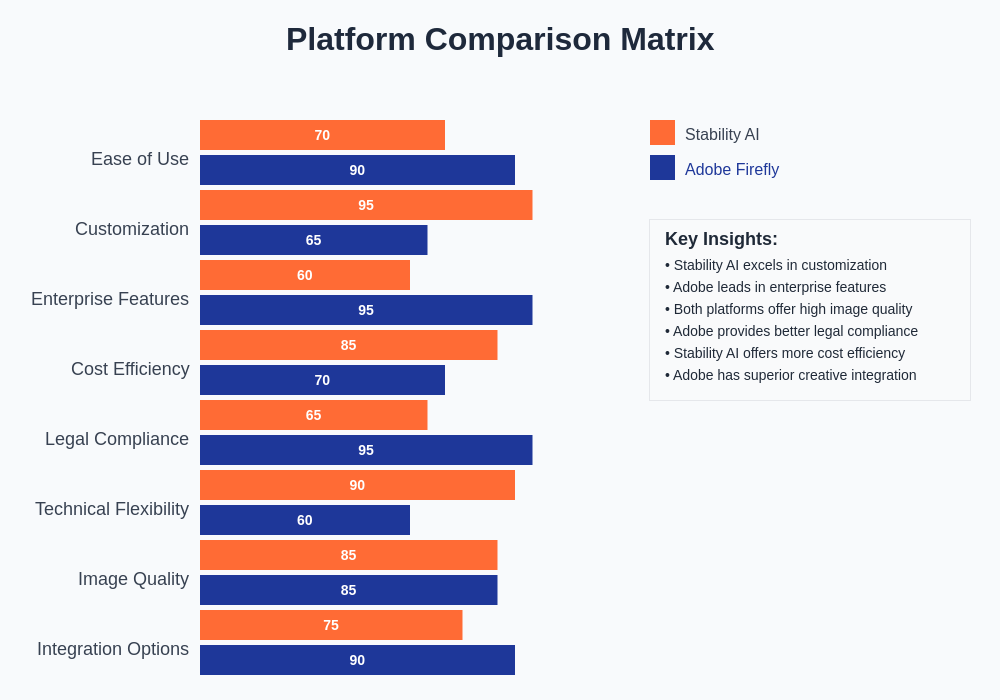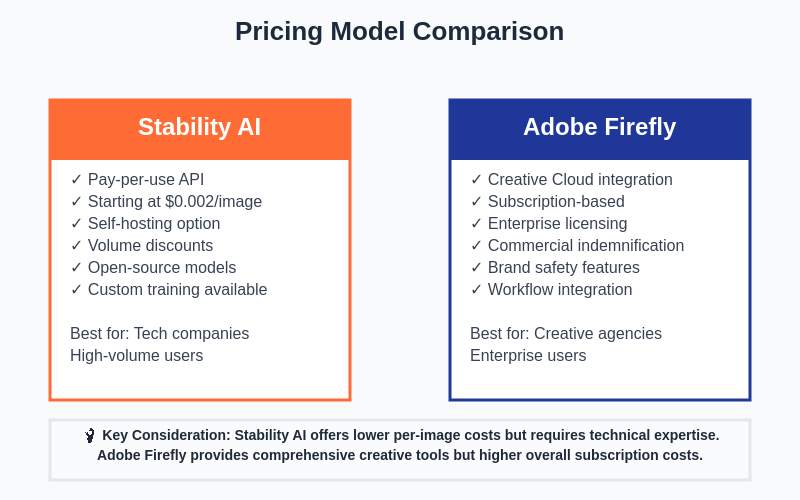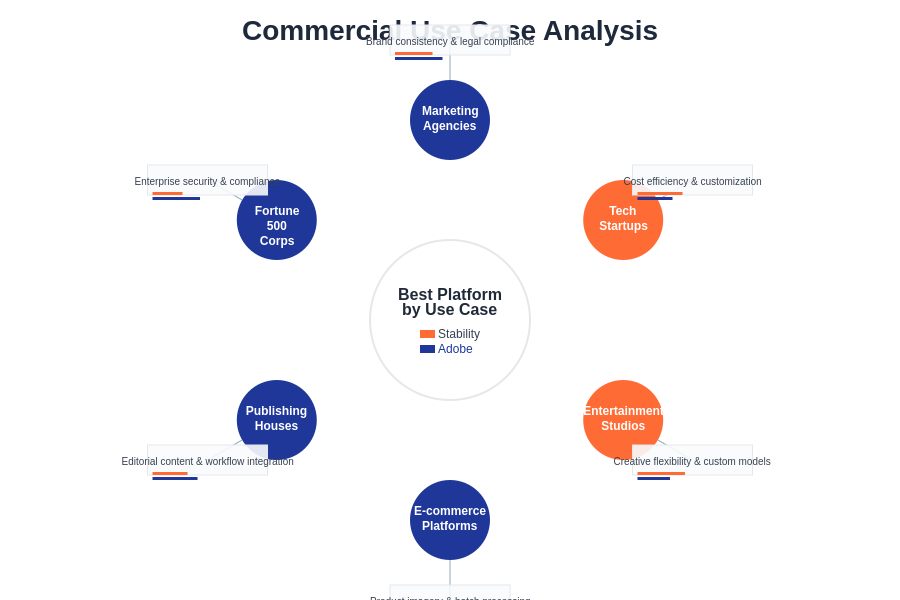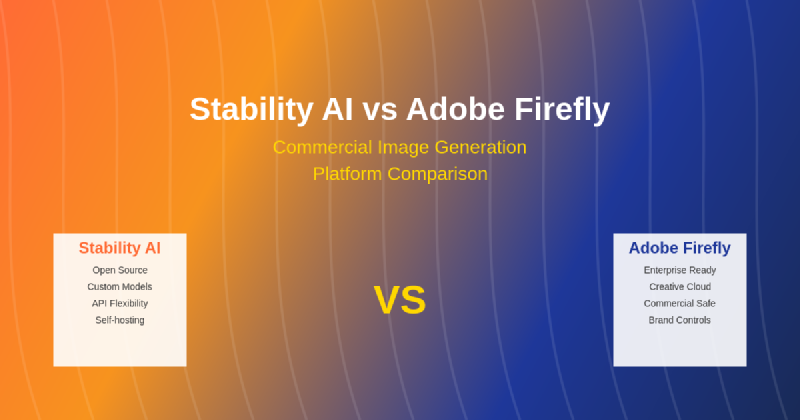The commercial landscape of AI-powered image generation has evolved into a competitive arena where two major platforms dominate the market: Stability AI’s suite of tools and Adobe Firefly. These platforms represent fundamentally different approaches to artificial intelligence-driven visual content creation, each offering unique advantages and addressing distinct commercial needs in the rapidly expanding digital economy.
Explore the latest AI image generation trends to understand how businesses are leveraging these technologies to transform their visual content strategies. The choice between Stability AI and Adobe Firefly often determines not only the quality and style of generated images but also the legal framework, cost structure, and integration capabilities that will define a company’s creative workflow for years to come.
Understanding the Commercial Landscape
The emergence of AI image generation technology has created unprecedented opportunities for businesses to produce high-quality visual content at scale while dramatically reducing traditional production costs and timelines. Commercial image generation platforms must address complex challenges including copyright compliance, licensing clarity, content quality consistency, and seamless integration with existing creative workflows. Both Stability AI and Adobe Firefly have developed comprehensive solutions to these challenges, though their approaches differ significantly in philosophy, implementation, and target market focus.
The commercial viability of AI-generated imagery depends heavily on factors such as licensing transparency, content originality guarantees, brand safety features, and the ability to maintain consistent visual identity across large-scale campaigns. Companies investing in AI image generation technology must carefully evaluate not only the immediate creative capabilities but also the long-term strategic implications of their platform choice, including vendor lock-in considerations, scalability limitations, and evolving regulatory compliance requirements.
Stability AI: Open Innovation and Flexibility
Stability AI has positioned itself as the champion of open-source AI development, offering unprecedented access to cutting-edge image generation models through various deployment options ranging from cloud-based APIs to self-hosted implementations. Their flagship Stable Diffusion model has become the foundation for countless commercial applications, providing businesses with the flexibility to customize, fine-tune, and deploy AI image generation capabilities according to their specific requirements and constraints.
The company’s commitment to open-source development has fostered an vibrant ecosystem of third-party tools, plugins, and extensions that enhance the core functionality while maintaining compatibility with existing creative workflows. This approach has proven particularly attractive to businesses with technical expertise who require granular control over their AI image generation pipeline, custom model training capabilities, or specialized deployment environments that traditional SaaS solutions cannot accommodate.
Stability AI’s commercial offerings include enterprise-grade APIs with guaranteed uptime, priority support, and enhanced security features designed for large-scale production environments. Their DreamStudio platform provides a user-friendly interface for non-technical users while maintaining access to advanced features such as custom model training, style transfer, and batch processing capabilities that enable efficient production of large volumes of branded content.
Adobe Firefly: Enterprise Integration and Brand Safety
Adobe Firefly represents the integration of AI image generation capabilities into the world’s most widely adopted creative software ecosystem, offering seamless compatibility with Photoshop, Illustrator, InDesign, and other Creative Cloud applications. This deep integration approach provides significant advantages for organizations already invested in Adobe’s creative tools, enabling AI-powered content generation without disrupting established creative workflows or requiring extensive retraining of creative teams.
The platform’s emphasis on brand safety and commercial licensing has made it particularly attractive to large enterprises and agencies who require absolute certainty regarding the legal status of generated content. Adobe’s approach to training data curation and licensing agreements provides comprehensive indemnification against copyright claims, addressing one of the most significant concerns facing businesses considering AI-generated content for commercial applications.
Discover advanced AI capabilities with Claude to enhance your creative workflows with intelligent assistance that complements both Stability AI and Adobe Firefly implementations. Adobe Firefly’s enterprise features include advanced content filtering, brand guideline enforcement, and collaborative approval workflows that ensure generated content aligns with corporate standards and regulatory requirements.
Technical Capabilities and Image Quality
The technical foundations of Stability AI and Adobe Firefly reflect their different approaches to AI model development and deployment. Stability AI’s models are built on open research principles, incorporating the latest advances in diffusion model architectures and training techniques. This approach has resulted in highly flexible models capable of producing diverse artistic styles, photorealistic imagery, and specialized content types through various conditioning mechanisms and fine-tuning approaches.
Adobe Firefly leverages Adobe’s extensive experience in digital imaging and color science to produce images with exceptional technical quality and consistency. The platform’s integration with Adobe’s proprietary color management systems, font libraries, and design templates ensures that generated content maintains professional standards suitable for high-end commercial applications including print advertising, digital marketing campaigns, and brand identity development.
Both platforms continue to evolve rapidly, with regular model updates and feature enhancements that improve image quality, reduce generation times, and expand creative possibilities. However, their development priorities differ significantly, with Stability AI focusing on model performance and flexibility while Adobe emphasizes integration, safety, and enterprise-grade reliability.
Licensing and Legal Considerations
The legal framework surrounding AI-generated content represents one of the most critical differentiators between Stability AI and Adobe Firefly, particularly for commercial applications where copyright compliance and licensing clarity are paramount. Adobe has invested heavily in creating a comprehensive legal framework that provides businesses with confidence in their ability to use generated content for commercial purposes without risk of copyright infringement claims.
Adobe’s approach includes careful curation of training data, explicit licensing agreements with content creators, and comprehensive indemnification policies that protect customers from potential legal challenges. This framework has been particularly valuable for large corporations, advertising agencies, and media companies who require absolute certainty regarding the legal status of their visual content.
Stability AI’s open-source approach provides different advantages, including greater transparency regarding model training and the ability for businesses to implement their own compliance frameworks. However, this approach requires more sophisticated legal and technical expertise to navigate the complex landscape of AI-generated content licensing, particularly in regulated industries or international markets with varying copyright laws.

The comparative analysis of platform capabilities reveals distinct strengths and optimization focuses that align with different commercial use cases and organizational requirements. Understanding these differences is crucial for making informed decisions about platform adoption and long-term creative strategy development.
Pricing Models and Cost Considerations
The economic implications of choosing between Stability AI and Adobe Firefly extend far beyond simple per-image generation costs, encompassing factors such as infrastructure requirements, staff training needs, integration complexity, and long-term scalability considerations. Both platforms offer multiple pricing tiers designed to accommodate different business sizes and usage patterns, though their cost structures reflect fundamentally different approaches to value delivery.
Stability AI’s pricing model emphasizes usage-based billing with options for both cloud-based API access and self-hosted deployments. This flexibility allows businesses to optimize costs based on their specific usage patterns, technical capabilities, and infrastructure preferences. High-volume users can achieve significant cost savings through self-hosting, while smaller businesses can benefit from the simplicity and predictability of cloud-based pricing.
Adobe Firefly’s pricing is integrated into the broader Creative Cloud ecosystem, providing value through bundled access to multiple creative applications and services. This approach can be cost-effective for organizations already using Adobe tools, as it eliminates the need for separate AI image generation subscriptions while providing seamless workflow integration. However, businesses not currently using Adobe products may find the overall cost of entry higher than standalone AI image generation solutions.

The comparison of pricing models reveals fundamental differences in how each platform approaches value delivery and cost optimization, with implications that extend beyond simple per-image costs to encompass total cost of ownership and strategic business alignment.
Integration and Workflow Considerations
The practical implementation of AI image generation technology requires careful consideration of existing creative workflows, technical infrastructure, and team capabilities. Adobe Firefly’s deep integration with Creative Cloud applications provides immediate productivity benefits for teams already proficient in Adobe tools, enabling AI-powered content generation without disrupting established creative processes or requiring extensive technical training.
Stability AI’s approach offers greater flexibility in terms of integration options, supporting everything from simple API calls to complex custom implementations that can be tailored to specific business requirements. This flexibility comes with increased technical complexity, requiring more sophisticated development resources to achieve optimal integration with existing systems and workflows.
Both platforms support various output formats, resolution options, and batch processing capabilities that enable efficient production of large volumes of content. However, their approaches to workflow optimization differ significantly, with Adobe focusing on creative suite integration and Stability AI emphasizing API flexibility and customization options.
Enhance your research capabilities with Perplexity to stay informed about rapidly evolving AI image generation technologies and their commercial applications. The choice between platforms often depends on existing technical infrastructure, team expertise, and long-term strategic objectives rather than purely on image generation capabilities.
Performance and Scalability
Commercial image generation applications require consistent performance, reliable uptime, and the ability to scale rapidly to meet varying demand patterns. Both Stability AI and Adobe Firefly have invested heavily in infrastructure capabilities that support enterprise-grade performance requirements, though their approaches to scalability reflect different architectural philosophies and target market priorities.
Stability AI’s cloud infrastructure is designed to handle high-volume API requests with low latency and high throughput, supporting applications that require real-time image generation or large-scale batch processing capabilities. Their self-hosting options provide additional control over performance characteristics, enabling businesses to optimize infrastructure configurations for their specific use cases and performance requirements.
Adobe Firefly leverages Adobe’s extensive cloud infrastructure and content delivery network to provide consistent performance across global markets while maintaining tight integration with Creative Cloud services. This approach ensures reliable access to AI image generation capabilities even during peak usage periods, with automatic scaling and load balancing that maintains consistent user experience across different geographic regions.
Security and Compliance Features
Enterprise adoption of AI image generation technology requires robust security measures and compliance capabilities that address various regulatory requirements and corporate governance standards. Both platforms have implemented comprehensive security frameworks, though their approaches reflect different priorities and target market requirements.
Adobe Firefly’s enterprise security features include advanced access controls, audit logging, content filtering, and compliance certifications that meet the requirements of large corporations and regulated industries. The platform’s integration with Adobe’s existing enterprise services provides centralized management capabilities and consistent security policies across the entire creative workflow.
Stability AI offers flexible security implementations that can be customized to meet specific organizational requirements, including options for on-premises deployment, custom authentication systems, and specialized compliance configurations. This approach provides greater control over security implementations but requires more technical expertise to configure and maintain appropriate security measures.
Creative Control and Customization
The degree of creative control and customization available through each platform significantly impacts their suitability for different commercial applications and artistic requirements. Stability AI’s open architecture provides extensive customization options, including the ability to fine-tune models, implement custom training pipelines, and develop specialized generation techniques tailored to specific brand requirements or artistic styles.
Adobe Firefly focuses on providing intuitive creative controls that integrate seamlessly with existing Adobe design tools, enabling designers to incorporate AI-generated elements into complex creative projects without requiring technical expertise in AI model operation. The platform’s emphasis on user experience and creative workflow integration makes it particularly suitable for traditional creative teams who need powerful AI capabilities without technical complexity.
Both platforms continue to expand their customization options and creative control features, though their development priorities reflect different assumptions about user expertise and workflow integration requirements. The choice between platforms often depends on whether an organization prioritizes technical flexibility or creative workflow integration.

The analysis of commercial use cases demonstrates how different platform strengths align with specific business requirements and industry applications. Understanding these alignments is crucial for selecting the platform that best supports long-term creative and business objectives.
Industry-Specific Applications
Different industries have varying requirements for AI-generated imagery, ranging from advertising and marketing applications that prioritize brand consistency and legal compliance to entertainment and gaming applications that emphasize creative flexibility and technical innovation. Both Stability AI and Adobe Firefly have developed features and partnerships that address specific industry requirements, though their strengths align with different market segments.
The advertising and marketing industry has generally gravitated toward Adobe Firefly due to its comprehensive legal framework, brand safety features, and integration with existing creative workflows used by agencies and marketing departments. The platform’s emphasis on commercial licensing clarity and professional creative tools makes it particularly suitable for large-scale advertising campaigns and branded content development.
Technology companies, gaming studios, and creative agencies with technical expertise often prefer Stability AI’s flexibility and customization options, which enable the development of specialized applications and unique creative workflows that differentiate their services and products. The platform’s open architecture supports innovative applications that require custom model training or specialized integration with proprietary systems.
Future Development and Innovation
The competitive landscape of AI image generation continues to evolve rapidly, with both Stability AI and Adobe investing heavily in research and development initiatives that will shape the future capabilities and market positioning of their platforms. Understanding the strategic direction and innovation priorities of each platform is crucial for making long-term technology adoption decisions.
Stability AI’s commitment to open-source development and research collaboration positions the platform at the forefront of technical innovation in AI image generation, with regular releases of new models, techniques, and capabilities that push the boundaries of what’s possible with artificial intelligence-driven content creation. This approach ensures rapid adoption of cutting-edge research developments but may result in less stability and predictability for enterprise applications.
Adobe’s integration-focused development strategy emphasizes the enhancement of creative workflows and the expansion of enterprise-grade features that support large-scale commercial deployment. Their substantial investment in research and development, combined with acquisitions of AI technology companies, positions Adobe Firefly for continued growth in enterprise markets while maintaining strong technical capabilities.
The future evolution of both platforms will likely include advances in areas such as video generation, 3D content creation, real-time generation capabilities, and enhanced integration with emerging technologies such as augmented reality and virtual reality applications. The choice between platforms should consider not only current capabilities but also the strategic direction and innovation capacity that will determine future feature availability and competitive positioning.
Making the Strategic Choice
The decision between Stability AI and Adobe Firefly ultimately depends on a complex evaluation of technical requirements, business objectives, existing infrastructure, team capabilities, and long-term strategic goals. Organizations must carefully assess their specific needs across multiple dimensions including creative control, legal compliance, cost optimization, workflow integration, and scalability requirements.
Companies with existing investments in Adobe Creative Cloud infrastructure, traditional creative teams, and strong requirements for legal compliance and brand safety will likely find Adobe Firefly to be the optimal choice. The platform’s emphasis on enterprise integration, comprehensive licensing framework, and creative workflow optimization provides clear value for organizations prioritizing stability and professional creative capabilities.
Organizations with technical expertise, custom application requirements, cost optimization priorities, or innovative creative workflows may benefit more from Stability AI’s flexibility and open architecture. The platform’s emphasis on customization, technical control, and rapid innovation makes it particularly suitable for companies that view AI image generation as a strategic technology advantage rather than simply a creative tool.
The evolving nature of AI image generation technology suggests that the optimal platform choice may change over time as both companies continue to develop new capabilities and address emerging market requirements. Organizations should consider not only current platform capabilities but also the strategic direction, innovation capacity, and market positioning that will influence future feature development and competitive advantages.
Disclaimer
This article is for informational purposes only and does not constitute professional advice regarding AI image generation platform selection or commercial licensing decisions. The views expressed are based on publicly available information about Stability AI and Adobe Firefly platforms as of the publication date. Readers should conduct their own research, including consultation with legal and technical experts, when making technology adoption decisions for commercial applications. Platform capabilities, pricing, and terms of service may change without notice, and this analysis may not reflect the most current information about either platform.
